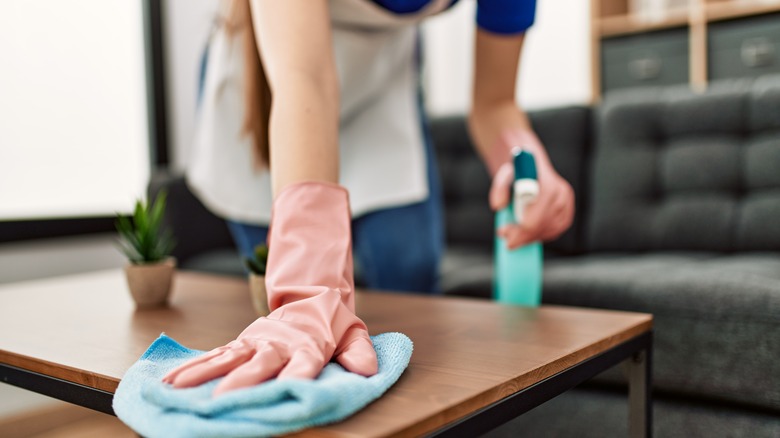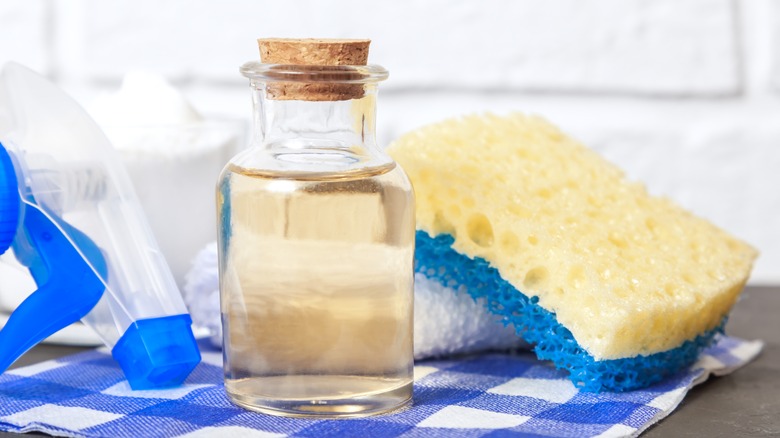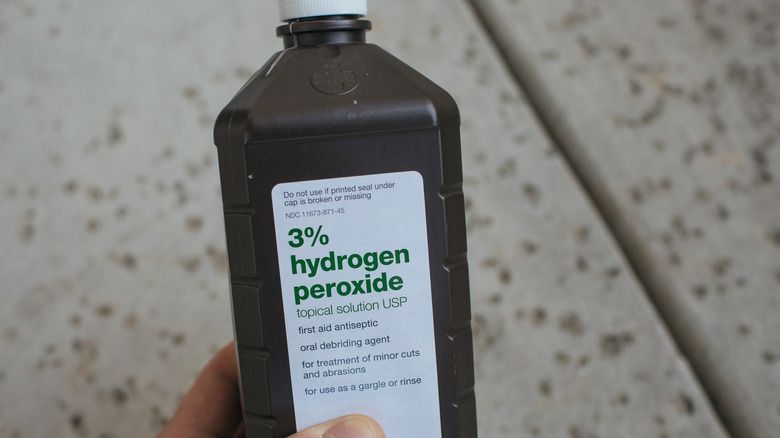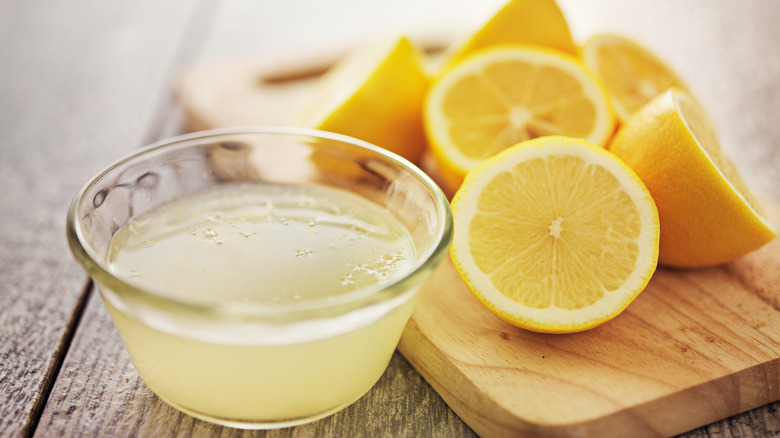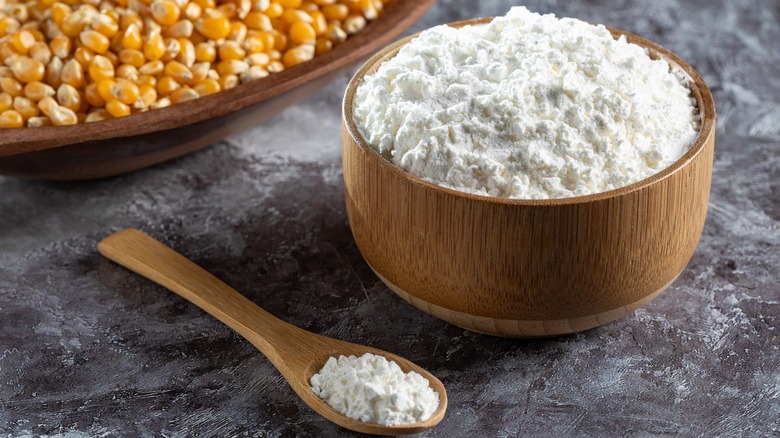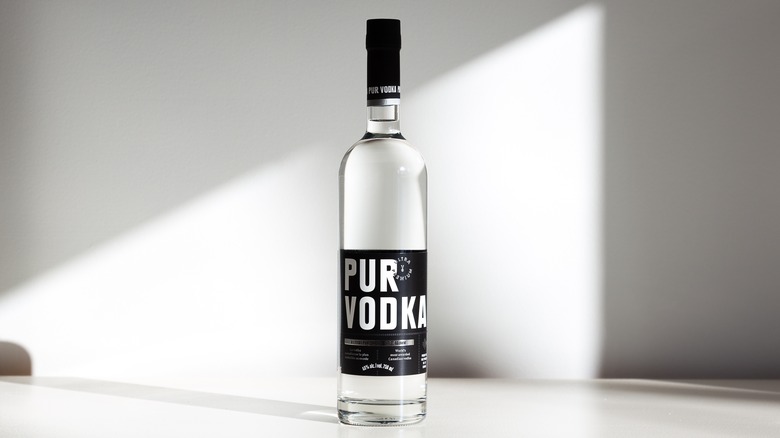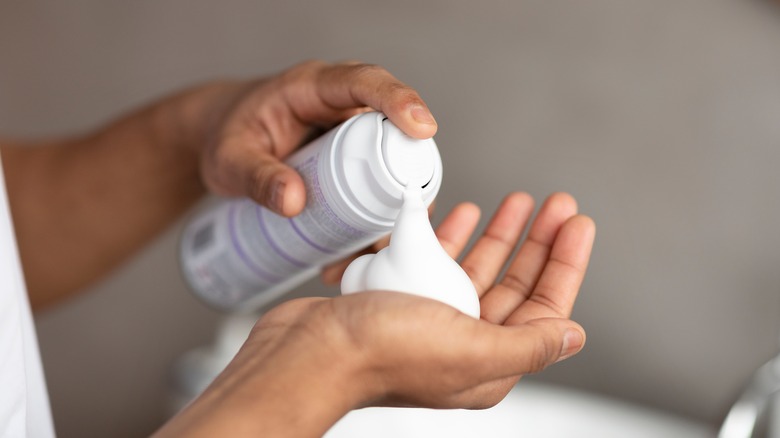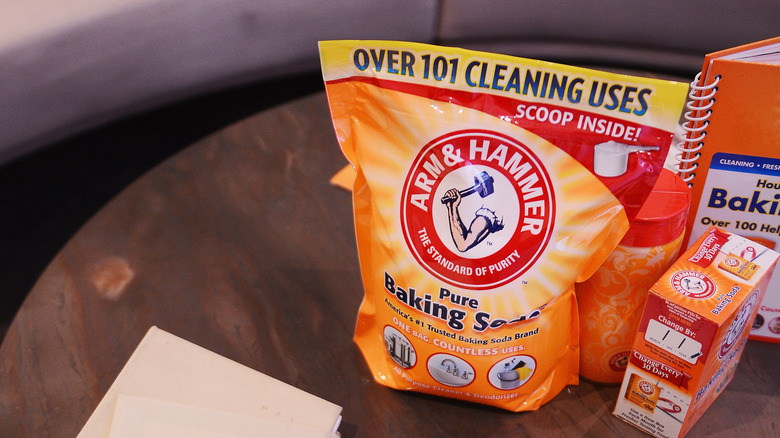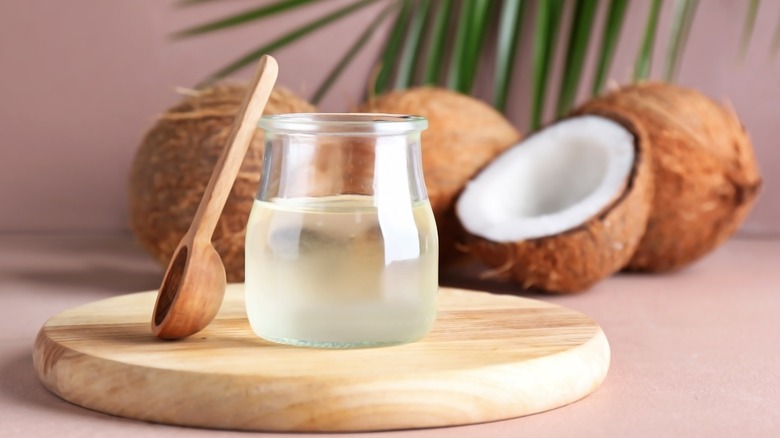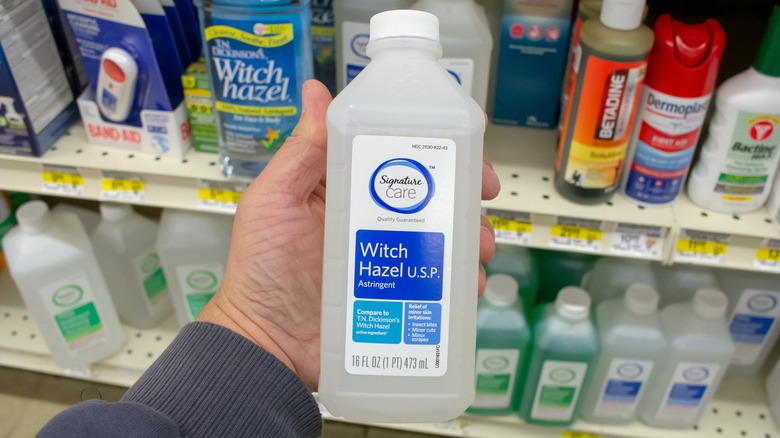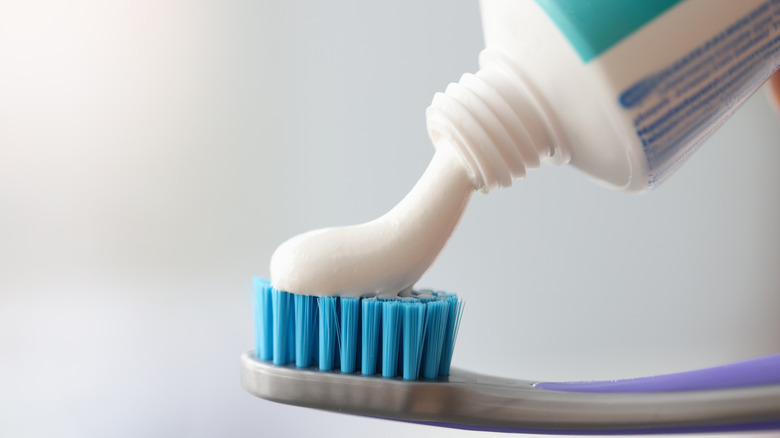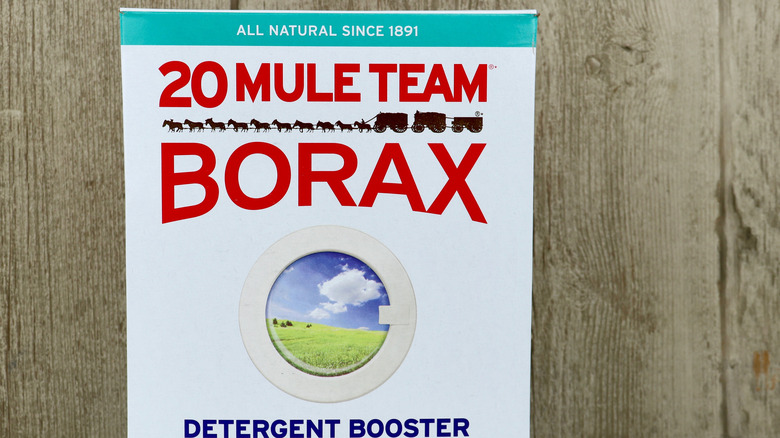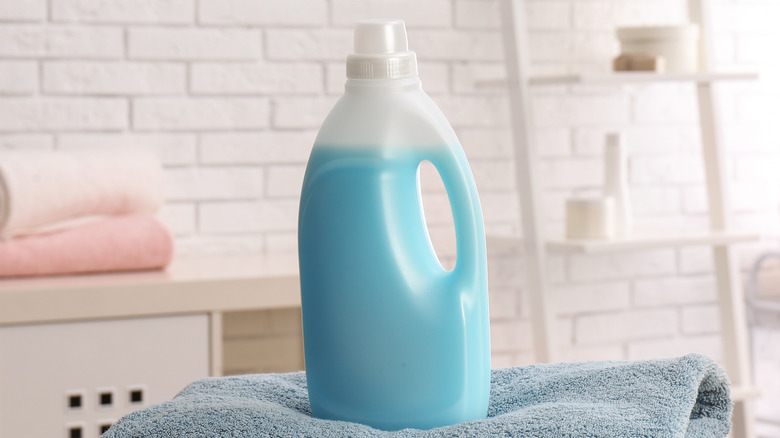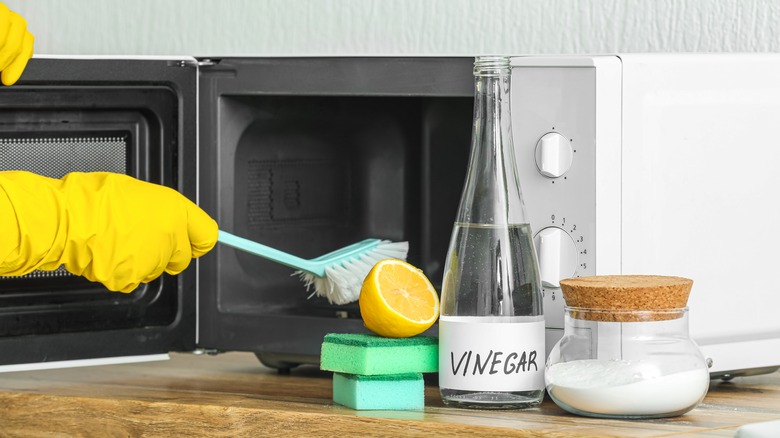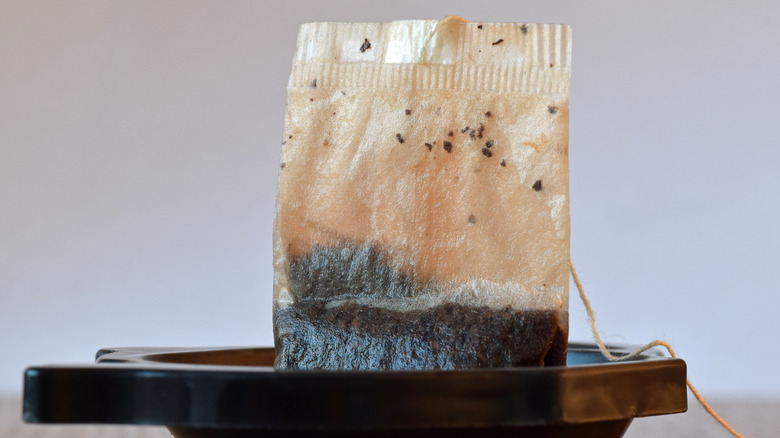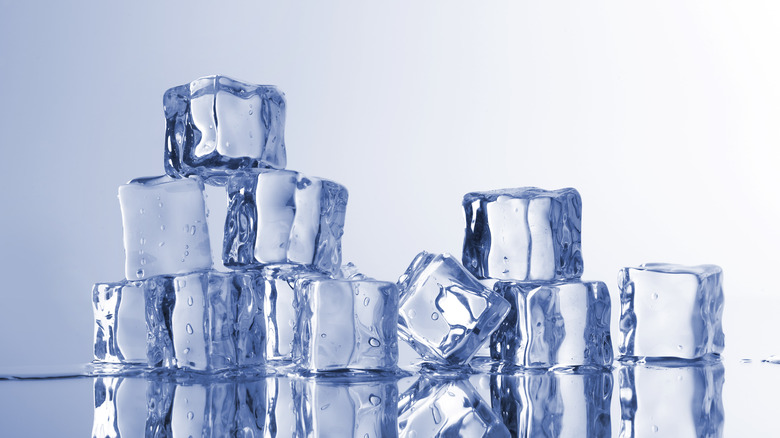15 Go-To Cleaning Substitutes That Will Get The Job Done
We may receive a commission on purchases made from links.
Have you ever decided to tackle a cleaning project around the house (perhaps one that you'd been putting off for a while), only to discover that you're out of the cleaner that you thought you had? It can be beyond frustrating to have to put off what you want to accomplish because you have to grab your keys and run to the store to buy the missing spray or powder.
But believe it or not, several cleaning substitutes, many of which you likely have in your home already, can take the place of store-bought cleaners. And even better, many of these substitutes are safer than their chemical cleanser counterparts, which often include toxic ingredients. Say goodbye to having to ventilate the room while spraying! Read on to learn more about some of the best cleaning substitutes that will take the place of kitchen sprays, bathroom cleaners, stain removers, and so many other store-bought sprays, gels, and powders.
1. Vinegar
Vinegar is for much more than cooking. It can help with a wide range of cleaning tasks in numerous rooms throughout the home. The best type of vinegar to use for cleaning is distilled white vinegar, which includes 5% acetic acid. While safe enough to handle or even consume, the vinegar's acidity helps break down and remove gunk on surfaces.
If you're looking for a natural substitute for kitchen sprays, either because you ran out of the one you normally use or are looking for something that won't introduce more chemicals around the areas you cook, look no further than vinegar. To use it to clean the kitchen, mix it with water in a spray bottle using a 1:1 ratio (equal parts of both liquids). Spray the mixture on countertops, cooktops, shelves in the refrigerator, and other surfaces. If there are any particularly sticky or caked-on messes, leave it to sit for a few minutes before wiping the surface down. Because vinegar is non-toxic, you can even use it to clean coffee pots, stainless steel cookware, cutting boards, and other kitchen tools that you wouldn't want to get anywhere near standard kitchen sprays.
2. Hydrogen peroxide
Hydrogen peroxide is another versatile product. You likely have a bottle of hydrogen peroxide in your medicine cabinet or under your bathroom sink for tending to wounds, but did you know that it could also double as a shower spray? If you have areas of mold or mildew along your shower tiles, skip chemical bleach-based cleansers and reach for that bottle of hydrogen peroxide in your medicine cabinet instead. Add it to a spray bottle and spray it directly over moldy or mildewy spots. Leave it to sit for about 10 minutes, then use a scrub brush to clean the tiles. Rinse everything, and your shower should be good as new again.
The reason hydrogen peroxide is such an effective cleaner comes down to its chemical composition. When the bonded hydrogen and oxygen atoms come into contact with surfaces, they create a reaction, loosening gunk and grime and disinfecting the surface. Unlike chemical bathroom cleaners, hydrogen peroxide is non-toxic and will not damage your lungs. If you habitually use more natural cleaning products, just keep in mind that you should never mix hydrogen peroxide and vinegar. According to the Missouri Poison Center, combining these two liquids can cause peracetic acid to form, which could irritate your eyes, skin, or lungs.
3. Lemon juice
Keeping your windows clean and streak-free can be a chore. However, you don't have to rely on store-bought glass and window cleaners for this task. Instead, you can use lemon juice. It has antibacterial and antiseptic properties, which make it an excellent choice for a range of cleaning tasks. Lemon juice is also acidic, which means that it can help breakdown grime, much like vinegar.
The next time you need to clean the windows in your home, try making a DIY glass and window cleaner using lemon. Add about 1 ½ cups of hot water to a spray bottle. Then pour in 3 tablespoons of lemon juice, and gently swirl the bottle to mix the two ingredients. Use this natural cleaner to spray your windows, then wipe them using a microfiber cloth for a streak-free finish. As a bonus, using lemon juice will leave behind a pleasant fragrance, to make your house smell as clean as your windows will look.
4. Cornstarch
If you have stains on your carpets from pets, kids, or any other number of causes, fear not. Open your pantry, and you may see the perfect substitute for carpet stain removers. Believe it or not, cornstarch can work well at removing stains and their corresponding odors from your carpets.
To use cornstarch as a stain remover, you'll want to mix it with a little water or distilled white vinegar. The mixture should be a very thick paste, so take care not to add too much liquid. Once the paste is prepared, spread it over the stain on the carpet and let it sit for several hours until stiff and dry. Once dry, vacuum up the excess cornstarch from the rug (if it is stuck on, you can gently scrape it off using a knife or kitchen scraper before vacuuming). The cornstarch should have absorbed the stain and its odor, leaving your carpet clean. For deep, set-in stains, you may need to repeat the steps above a few times.
5. Gin or vodka
Did you know gin and vodka can help keep your jewelry clean? In fact, using gin was a trick that some members of Queen Elizabeth's staff used to swear by when cleaning the royal jewels. Try dipping jewelry with diamonds and other gemstones in a glass with a little bit of gin or vodka. Leave the jewelry to soak for at least four hours.
When you return to pull out your jewelry, you should notice that it looks much cleaner and more brilliant. So, how exactly does alcohol clean diamonds and other stones? The secret lies in the higher ethanol content of these two alcohols. When the gems are left to soak, it acts as a natural solvent, breaking down and getting rid of any grime on the stone. If this cleaning method was good enough for the Queen, it might be worth giving it a shot with your gems and jewels.
6. Shaving cream
Fear not if your stainless steel appliances always seem to be covered in fingerprints or hard water stains. You don't have to run out and buy a specialized cleaning product with questionable ingredients. Instead, you can just head to your bathroom cabinet and pull out a can of shaving cream (opt for a basic, fragrance-free formula for best results). Simply cover the stainless steel surfaces with some shaving cream — it doesn't take too much — then wipe it off using a damp cloth.
Once most of the shaving cream has been removed from the surface, use a clean and dry microfiber towel to finish the job. Rub the surface until the classic stainless shine returns. The shaving cream works to remove the stains (you can leave it to sit for a few extra minutes on hard water spots and stains) and leaves your stainless steel stove, dishwasher, refrigerator, and other appliances looking like new.
7. Baking soda
Our mugs, dishware, and plastic storage containers can develop stains over time. Even when we know these items are clean, they can still look dirty and dingy. Baking soda can help you rejuvenate these items throughout your kitchen, giving them a new shot at life. Baking soda is slightly abrasive and works to release the particles that caused the stain. It also absorbs odors, so if any of the stained items also have an unpleasant odor, baking soda should help with that too.
To use baking soda as a stain remover, mix it with a small amount of water and vinegar to form a thick paste. Apply the paste over the stained area, leave it to sit for about half an hour, and then wipe it off with a sponge. If needed, you can repeat the steps an additional time for more stubborn stains. Once the stain is removed, rewash the item as usual before using it. You can use this paste to tackle a variety of stains in the kitchen, including coffee- or tea-stained mugs, stained plasticware, cutting boards, countertops, and more.
8. Coconut oil
If you're looking for a more natural way to clean your shower and want to stay away from bleach and other harsh chemicals, the solution you need may be sitting in your pantry right now. Coconut oil can actually be used to clean a variety of surfaces, including shower walls and bathtubs. Place some coconut oil on a rag or scrub brush and use it to wipe down all the surfaces in your shower or bathtub. Once that's done, rinse with warm water, and you should notice that everything looks much cleaner.
The reason coconut oil can be an effective cleaner — and a particularly good choice for showers — is because of the lauric acid found in it. Lauric acid works as an antimicrobial, giving surfaces a thorough cleaning. If you want to boost the power of the coconut oil or tackle any particularly tough stains, try mixing it with some baking soda. As noted above, baking soda is a great stain remover.
9. Witch hazel
You may have taken witch hazel to relieve symptoms of diarrhea, vomiting, inflammation, skin irritations, and other more serious conditions. The liquid from the witch hazel plant is extracted and then taken orally or applied directly to the skin, depending on the condition. It may seem strange to think that the same substance that can help with medical conditions can also help keep your floors clean, but it is true. You can use witch hazel on tile, vinyl, and linoleum floors, but it isn't the best solution for your hardwood floors.
Fill your mop bucket with about 1 gallon of warm water. Then, add between ⅓ and ⅔ of a cup of witch hazel and mix it in well. Dip your mop or cleaning brush in the homemade solution, and use it to clean your floor. The witch hazel will help break down dirt and debris, leaving your floors clean and shiny. If you want a quicker, less-involved cleaning job, witch hazel can still help. Instead of mixing a solution in your mop bucket, add some witch hazel and a little bit of water to a spray bottle and spritz the floors in your home before wiping them down with a microfiber towel or mop head.
10. Toothpaste
If your white shoes have seen better days, toothpaste may be able to help you rejuvenate them. White, baking soda-based toothpastes — stay away from gels — can work wonders at taking scuff marks and dirt off tennis shoes. An old toothbrush will work as the perfect cleaning tool to complement the toothpaste.
Simply apply a little white toothpaste onto the toothbrush head and use it to tackle any stained or dirty areas on the shoes. Scrubbing in a circular motion will be the most effective way to release stains and messes. After you've cleaned all the necessary areas, allow the toothpaste to sit for about 15 minutes, then wipe it off using a damp towel. You may need to repeat the steps above a few times for more stubborn stains. In addition to working well to remove stains from the canvas and fabric parts of shoes, a whitening toothpaste can also be an effective cleaner for the rubber edges of your tennis shoes. Apply it to these areas with a toothbrush, following the same methods described above.
11. Borax
No one enjoys cleaning the toilet, but it is one of those tasks that we just can't skip. However, you can skip the bleach- and chemical-based cleaners you want to keep out of your house. The ideal substitute may be waiting in your laundry room right now. Borax is traditionally used as a laundry booster, but its chemical makeup also makes it an effective toilet bowl cleaner. With its pH of 9.5, it is on the alkaline side. That means it can work to remove a variety of substances, such as oils, fats, and anything acidic, when mixed with water.
To use Borax as a toilet bowl cleaner, add approximately 1 cup to the water in your toilet bowl at night. Dump it in slowly, trying to get some of the powder to coat the sides of the toilet. You may even want to put on gloves to apply some of it along the toilet's upper rim to achieve a thorough clean. Once the Borax powder has been applied to the inside of the toilet bowl, let it sit there for several hours, ideally overnight. When you wake up, take your toilet brush and give the inside of the bowl and along the rim a good scrubbing. Flush and admire how effective the Borax was at getting rid of stains.
12. Fabric softener
Baseboards can get dirty so easily. After all, they're right along the floor where dirt and other gunk get tracked in. Another item that is probably in your laundry room right now can help you tackle this cleaning task. Try cleaning your baseboards with fabric softener, and you won't want to go back to whatever cleaners you used to use. Not only is fabric softener an effective cleaner for this task, but it is also really easy to use.
Transfer a little of your fabric softener out of the bottle and into a spray bottle. You'll want to be able to control how much comes out, which won't be possible with the wide open mouth on the package you get from the store. You'll want to add approximately 1/2 a cup of fabric softener and about 2 ½ cups of water. Put the lid on the spray bottle and gently swirl the mixture to combine the two ingredients.
Spray the mixture directly on your baseboards, then go around with a dry microfiber cloth to wipe them down. For carpeted rooms, you may only want to spray a small section at a time to prevent the mixture from dripping onto the carpets. Alternatively, you could spray the solution directly onto the microfiber cloth to eliminate the chance of it dripping down onto the floor. One of the biggest benefits of using fabric softener to clean your baseboards is that it can also help them stay cleaner for longer. It will leave behind a slight coating on the baseboards, which will work to repel dust and other debris from sticking to them.
13. Vinegar and steam
It's no secret that vinegar is a powerhouse ingredient when it comes to homemade cleaning solutions. And one of its many possible applications is to clean the grimy insides of a microwave. The acidity of vinegar alone makes it a grease-cutting hero, but when diluted with water and allowed to boil in the microwave, the mixture will generate steam that makes it satisfyingly easy to wipe away all of that built-up food residue.
The pros at OvenClean recommend a simple protocol for this microwave cleaning method. First, combine about 2 cups of water with 2 tablespoons of distilled white vinegar in a microwave-safe bowl. Set the microwave on full power for five minutes and allow it to run for that duration, or until the mixture begins boiling. Then, leaving the microwave closed, allow the bowl to sit for another few minutes. This will give the steam and vinegar time to soften any hardened or burnt food splatters. Once a few minutes have passed, carefully remove the hot bowl from the microwave and tackle the surfaces, including the turntable, with a sponge, and then a dry cloth.
If you're looking to make your cleaning experience all the more enjoyable, consider swapping your plain old microwave-safe bowl for the Angry Mama Microwave Oven Steam Cleaner. Is it just another vessel in which to add your water and vinegar mixture? Yes. But will its fun design also encourage you to clean your microwave more often? Very possibly.
14. Black tea
The black tea in your kitchen drawers isn't just useful for a caffeinated pick-me-up. It can also be a convenient and easy way to clean hardwood floors. Black tea contains tannins, a type of plant compound, which is shown to have antimicrobial properties and a staining effect on wood. In fact, tannic acid powder, a much more concentrated substance than tea, is regularly used to stain and finish lumber. However, black tea will offer a less dramatic, but still visible richness and darkening of your wood floors, depending on how concentrated it is.
To clean your hardwood floors, you'll need: plenty of tea bags, water to steep them in, and a mop of your choice. Start by boiling a pot of water, and steeping anywhere from five to eight tea bags, depending on how much color you want to impart. Allow to steep for 10 minutes or so, and then cool down. Once cool enough, use a mop, microfiber or traditional, to absorb and wring out the tea. Be sure to do this well, as too wet of a mop can cause water damage and warping to your floors. Then, allow the tea to air dry, and enjoy your newly freshened floors!
15. Ice
With all of the gunk that gets sent down your garbage disposal, it will inevitably need to be cleaned from time to time. But you don't need harsh chemical drain un-cloggers to clear the disposal of residual food waste and lingering odors. You just need ice and some dish soap.
You may have seen the viral TikTok where cramming a bunch of ice down the garbage disposal dredges up some pretty nasty-looking brown liquid from the drain. But you don't necessarily need that much ice. The experts at Roto-Rooter explain that just a single large glass of cubes along with a little dish soap or baking soda should do the trick. Once the ice cubes are pulverized, flush the drain with plenty of hot water. You could add peeled and sliced lemon or a splash of vinegar for additional deodorizing power. Whichever gentle cleaning ingredient you choose, it will work to freshen the blades while the ice mechanically dislodges unsavory scraps that have been waiting to move through your pipes.
